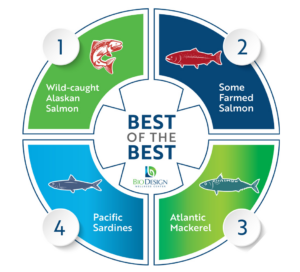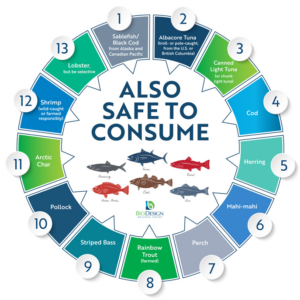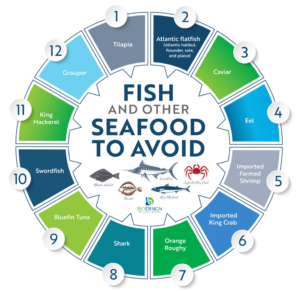When most of us eat fish at home or choose fish over beef or pork at a restaurant, we think we’re choosing the healthy alternative. After all, fish is a lean, white protein, packed with healthy omega 3 fatty acids along with a broad range of essential vitamins and minerals.
Many studies suggest that a diet rich in fish and other seafood may lower the risk of heart attack and stroke; support brain development, health, and function; prevent and treat depression; reduce the risk of autoimmune diseases; prevent asthma in children; improve the quality of sleep; a deliver a host of additional health benefits.
Unfortunately, not all fish are safe and healthy to eat, and some we should avoid eating for other reasons — such as poor fisheries management, which can negatively impact the environment, reduce fish populations, and disrupt sensitive food chains.
So, which fish should you be eating, and which should you avoid and why? In this post, we offer the guidance you need to make the safest, healthiest, and most environmentally responsible selections.
The Safest and Healthiest Fish to Eat
 The healthiest, most sustainable fish on your menu of fish to eat meet the following criteria:
The healthiest, most sustainable fish on your menu of fish to eat meet the following criteria:
- High in protein
- High in essential vitamins and minerals
- High in omega 3 fatty acids
- Low in omega 6 fatty acids, which are inflammatory
- Low in contaminants, such as mercury
- Wild caught using environmentally responsible fishing methods, or farm-raised following best practices in aquaculture
- Harvested from sustainable fisheries (not overfished), or raised on farms built and managed to have a minimal impact on the environment
Only a few fish qualify for this best-of-the-best list:
Salmon
Wild-caught Alaskan salmon is generally considered one of the healthiest seafood choices. It checks all the boxes for a healthy fish to eat:
- Free of artificial coloring, growth hormones, pharmaceuticals, and other unnatural chemicals
- High in omega-3 fatty acids
- Good source of Vitamins A, C, D, E, and B vitamins, potassium, and selenium
- Excellent source of protein
- Low in saturated fats
- Low in calories
Farmed salmon can be a very healthy alternative, depending on who’s doing the farming. In fact, in some ways, farmed salmon are even healthier than their wild-caught cousins because they can be raised on a nutrient-rich diet in a more controlled environment with less exposure to contaminants.
In the U.S., federal and state regulations ensure that salmon farming has a minimal impact on the environment. Atlantic salmon farmed in the U.S. are spawned and raised in on-land hatcheries and then transferred to net pens in coastal waters. They’re not fed or injected with dyes, and the use of antibiotics is strictly limited.
Pacific sardines
Pacific sardines are a great source of protein, omega-3 fatty acids, calcium, and iron. They’re also a good source of Vitamin B12, selenium, phosphorous, Vitamin D, niacin (Vitamin B3), and iodine. Because they’re small fish (lower on the food chain), they’re lower in mercury and other contaminants than are larger fish, such as tuna.
Atlantic mackerel
Atlantic mackerel is often compared to tuna. In fact, they’re members of the same family, Scombridae. They’re big, oily fish with a firm texture that are often packed in oil and canned.
Mackerel have a few advantages over tuna:
- Smaller with a shorter lifespan, so they’re not as prone to developing a buildup of contaminants in their bodies
- Oilier than tuna
- Milder taste
- Higher in selenium and Vitamin B12
To be fair, tuna is higher in protein, Vitamins A, B1, B2, and B3, and phosphorous. Also, mackerel is higher in sodium and contains four times more saturated fat than tuna.
Other Fish That Are Safe and Healthy to Eat
 While salmon, Pacific sardines, and Atlantic mackerel are at the top of the list of healthy, safe, and sustainable seafoods, your choices aren’t limited to those three. Here are some additional recommendations:
While salmon, Pacific sardines, and Atlantic mackerel are at the top of the list of healthy, safe, and sustainable seafoods, your choices aren’t limited to those three. Here are some additional recommendations:
- Sablefish/black cod from Alaska and Canadian Pacific
- Albacore tuna that’s troll-caught or pole-caught, from the U.S. or British Columbia
- Canned light tuna (or chunk light tuna) is typically skipjack tuna — a smaller species that’s generally lower in mercury and other contaminants but may also be lower in omega 3 fatty acids (consume any tuna in moderation — a maximum of two to three servings per week, less for children — and avoid it if you’re pregnant or planning to get pregnant)
- Cod — a flaky white fish and a great source of phosphorous, niacin, and Vitamin B12
- Herring — a fatty fish similar to sardines
- Mahi-mahi (aka the dolphinfish) — a firm, tropical fish (definitely not a dolphin)
- Perch — a white fish with a medium texture and a mild taste that comes from the ocean or fresh water
- Rainbow trout (farmed) — one of the best fish in terms of environmental impact
- Striped bass — has a firm, flaky texture and is flavorful
- Pollock has a mild flavor and a light texture — it the fish most often used for fish sticks and other breaded fish products
- Arctic char is like a cross between salmon and trout
- Shrimp (wild-caught or farmed responsibly) — be very careful of any imported farmed shrimp for reasons explained later in this post
- Lobster, but be selective — for example, the American lobster from most sources is recommended, while the Caribbean spiny lobster from most sources is to be avoided
Wild-Caught Versus Farm-Raised
Farm-raised fish have gotten a bad reputation over the years, mostly because of poor practices in the industry, especially in areas where aquaculture is not strictly regulated. Fish farms are susceptible to the following problems:
- Poor water quality — fish (and other animals such as shrimp) may be raised in ponds, tanks, or other bodies of water that are highly polluted and become even more polluted over time. When raised in ponds in agricultural areas, pesticides and other chemicals used on crops in nearby fields can leach into the ponds.
- Overcrowding increases susceptibility to disease and exposes the fish to stressful conditions that negatively impact their health and nutritional value.
- Antibiotics and other substances used to prevent and treat illness contaminate the fish.
- Poor quality feed can reduce the nutritional value of the fish, not to mention their health.
- Irresponsible farming methods harm the environment. For example, thousands of acres of mangrove forests, which capture carbon, protect coastlines against storms and erosion, and create a valuable habitat for all sorts of sea creatures, have been destroyed to feed the growing demand for shrimp.
- Irresponsible and unsustainable fishing and production methods may also be used to harvest the fish used to feed the farm-raised fish.
When you’re trying to produce enough seafood to support the nutritional needs of the nearly 8 billion human beings who inhabit the planet while preserving the ocean for its trillions of inhabitants, aquaculture is a promising solution. Don’t rule out farm-raised seafood. Aquaculture offers the following potential benefits when done properly:
- Has the potential of having a minimal negative impact on the environment
- May help to reduce problems such as overfishing, bycatch, and fishing methods that harm the environment (bycatch is the catching and discarding of fish that fishermen do not want, cannot sell, or are not allowed to keep)
- May reduce levels of mercury and other contaminants in seafood
- May increase the nutritional value of seafood
Fish and Other Seafoods You Should Mostly Avoid
 Some fish you simply need to scratch off your menu for one or more of the following reasons:
Some fish you simply need to scratch off your menu for one or more of the following reasons:
- They’re unsafe (contaminants)
- They’re unhealthy (from a nutritional perspective)
- They’re unsustainable (populations are threatened)
- They’re grown and harvested in ways that damage the environment or harm other fish or animals
Unfortunately, this list is quite long and contains some of the most popular seafood on the menu.
Tilapia
Tilapia is one of the most widely consumed fish in America, and most of the tilapia that’s consumed is farm-raised, not wild-caught. But the problem with this fish is its nutrient profile — it’s relatively low in healthy omega 3 fatty acids and very high in inflammatory omega 6 fatty acids. In some ways, tilapia is nearly as bad for you as bacon.
A diet that’s high in inflammatory foods increases your risk for developing a broad range of illnesses, including chronic conditions such as cardiovascular disease, cancer, and diabetes, along with autoimmune disorders.
Wild-caught tilapia is better than farm-raised, and tilapia raised on farms in the U.S., Canada, Netherlands, Ecuador, and Peru are better than those raised on fish farms in China. But avoiding or limiting your consumption of tilapia may be the healthiest choice.
Atlantic flatfish (Atlantic halibut, flounder, sole, and plaice)
Scratch Atlantic flatfish off your list of seafoods for three reasons — pollution, overfishing, and bycatch:
- Pollution along the east coast of the U.S. has resulted in high levels of contaminants in these fish.
- Overfishing of these fish along the east coast has reduced their populations to unsustainable levels. According to Food & Water Watch, the population of these fish represent one percent of what would be needed for a long-term sustainable fishery.
- Flatfish fisheries are prone to excessive bycatch — organisms that are caught by mistake and thrown back, usually dead or dying. According to the National Marine Fisheries Service, commercial fishermen in the U.S. throw about 2 billion pounds of bycatch overboard each year. The California gillnet fishery that targets Pacific halibut was singled out as one of the worst.
Caviar
Caviar consists of eggs harvested from sturgeon traditionally from the Caspian and Black Seas. The caviar in highest demand is harvested from the Beluga sturgeon — a very large fish that can live 100 years.
Females can carry several hundred pounds of caviar, which may sell for up to $3,500 per pound. Tragically, the Beluga sturgeon has disappeared from several seas and rivers in which it used to live, and many scientists fear that it is critically endangered and vulnerable to extinction.
For a sustainable alternative, Seafood Watch recommends caviar from blue sturgeon raised in recirculating aquaculture systems in the U.S.
Eel
Eel is a good source of protein, omega 3 fatty acids, and a wide range of vitamins and minerals, including Vitamins A, B12, D, E, niacin (B3), thiamin (B1), and choline, phosphorous, zinc, selenium, and potassium. However, you should avoid consuming eel for two reasons:
- They tend to readily absorb and store harmful chemicals and contaminants, such as such as polychlorinated biphenyls (PCBs) and flame retardants. In certain states, including New Jersey, river eels are so contaminated that adults are advised to consume no more than one serving per year (none for children).
- In environments where pollution is less prevalent, the bigger problem is overfishing.
Monterey Bay Aquarium’s Seafood Watch lists only three sources of American eel as good alternatives and recommends avoiding European and Japan eels and any American eels farmed in China, South Korea, Taiwan, or Japan or harvested in the waters of the Northwest Atlantic Ocean off the U.S. coast.
Imported farmed shrimp
Farm-raised shrimp account for nearly 90 percent of all shrimp consumed in the U.S., and about 55 percent is imported from countries where farming practices may be unsafe, unsustainable, or harmful to the environment.
As a result, imported shrimp are more likely to carry salmonella or parasites and be contaminated with a host of harmful pesticides, antibiotics, and other chemicals, including malachite green, rotenone, organotin, and 4-hexylresorcinol — a food additive used to prevent discoloration in shrimp that may reduce sperm count in men and increase breast cancer risk in women.
All but one of the pesticides used globally in shrimp production are banned for use in U.S. shrimp farms.
Imported king crab
About 75 percent of king crab sold in the U.S. is imported from Russia, where unsustainable fishing practices are common, and mislabeling of products is rampant. Just because the label claims that the king crab legs you’re buying are from Alaska doesn’t mean they really are.
Orange roughy
Orange roughy (also known as slimehead) are delicious and generally safe and healthy to eat, but they’re severely overfished. They don’t reach sexual maturity until they’re at least 20 years old, so when they’re overfished, populations take a half century or longer to recover.
They’re also one of the longest living marine species, living up to 150 years. Due partially to their longevity, they’re susceptible to having higher than average mercury levels, so they can be harmful if consumed in large amounts.
Shark
Eating certain sharks from certain fisheries in moderation is okay, but generally speaking, you should steer clear of eating sharks for two reasons:
- They’re often near or at the top of the food chain, which translates into higher mercury levels.
- Their populations are often depleted due to overfishing (shark fins are a delicacy in some Asian countries), bycatch, and senseless killing driven by an irrational fear of sharks. Now, you may think that killing a top predator is good for the rest of the fish populations, but it’s actually not. These predators play a key role in maintaining healthy food webs — when they’re eliminated, fish populations can collapse.
Bluefin Tuna
Bluefin tuna (both Atlantic and Pacific varieties) are in high demand at sushi bars, but you need to avoid it for the following reasons:
- Bluefin tuna are large predatory fish that are susceptible to building up high levels of mercury in their bodies.
- They’ve been overfished to the point of near extinction. Bluefin tuna numbers are at just 2.6 percent of historic population levels. Unfortunately, to feed the high demand for it, fisheries managers are still allowing commercial fishing operations to target it.
Swordfish
Swordfish tends to be high in mercury, which is the number one reason not to eat it. If you’re pregnant or planning a pregnancy, avoid swordfish altogether. Otherwise, limit consumption to one serving per month — none for children.
King mackerel
While Atlantic mackerel is on our list of safest and healthiest fish to eat, the same can’t be said for the king mackerel or, to a lesser degree, the Spanish mackerel. Both these selections tend to be high in mercury.
Children and pregnant women (or those planning to become pregnant) should avoid it entirely. Adults who aren’t pregnant or planning to get pregnant should limit their consumption to a couple servings per month.
Grouper
Grouper used to be a top choice on the seafood menu, but that was before overfishing and pollution entered the picture. Now, you should generally avoid most grouper for the following reasons:
- Moderately high mercury levels
- Overfishing
- Seafood fraud — other, cheaper and less safe and healthy fish, are commonly sold as “grouper,” including pangasius (Vietnamese catfish), king mackerel, and whitefin weakfish
Do Your Research
Making healthy, sustainable seafood choices isn’t simply a matter of choosing specific fish and excluding others. Several factors must be considered, including where the seafood comes from and how it’s grown and harvested, and these factors can change over time.In fact, a fish we recommend today may be wise to avoid at some point in the future.
Here are a few suggestions for making better informed choices of which seafood to eat and which to avoid:
- Search the Monterey Bay Aquarium’s Seafood Watch database at www.seafoodwatch.org to see which seafoods are certified safe and sustainable, which are good alternatives, and which you should avoid.
- Read the labels when buying fish. Make sure the seafood you’re buying is labeled as “Certified Sustainable Seafood” by the Marine Stewardship Council (MSC) or is “Best Aquaculture Practices” (BAP) certified for farm-raised products. In the U.S. and Canada, seafood products must also be labeled with a Country of Origin declaration and a Method of Production designation.
- Buy local to avoid imported products that may not be as carefully regulated.
- Ask questions before ordering seafood at a restaurant to find out whether the item was wild-caught or farm-raised, its country of origin, and whether it is MSC or BAP certified.
Also, we recommend that you opt for fully cooked over raw seafood and grilled or broiled over breaded and fried. Raw seafood is more likely to carry harmful bacteria or parasites.
High-quality, sustainable seafood is an excellent source of protein, vitamins, minerals, and omega 3 fatty acids, and we encourage you to make it a routine part of your diet.
We only caution you to educate yourself and make well-informed seafood choices for yourself and your family.
= = = = = = = = = = =
Disclaimer: The information in this blog post about consuming seafood mold is provided for general informational purposes only and may not reflect current medical thinking or practices. No information contained in this post should be construed as medical advice from the medical staff at BioDesign Wellness Center, Inc., nor is this post intended to be a substitute for medical counsel on any subject matter. No reader of this post should act or refrain from acting on the basis of any information included in, or accessible through, this post without seeking the appropriate medical advice on the particular facts and circumstances at issue from a licensed medical professional in the recipient’s state, country or other appropriate licensing jurisdiction.

